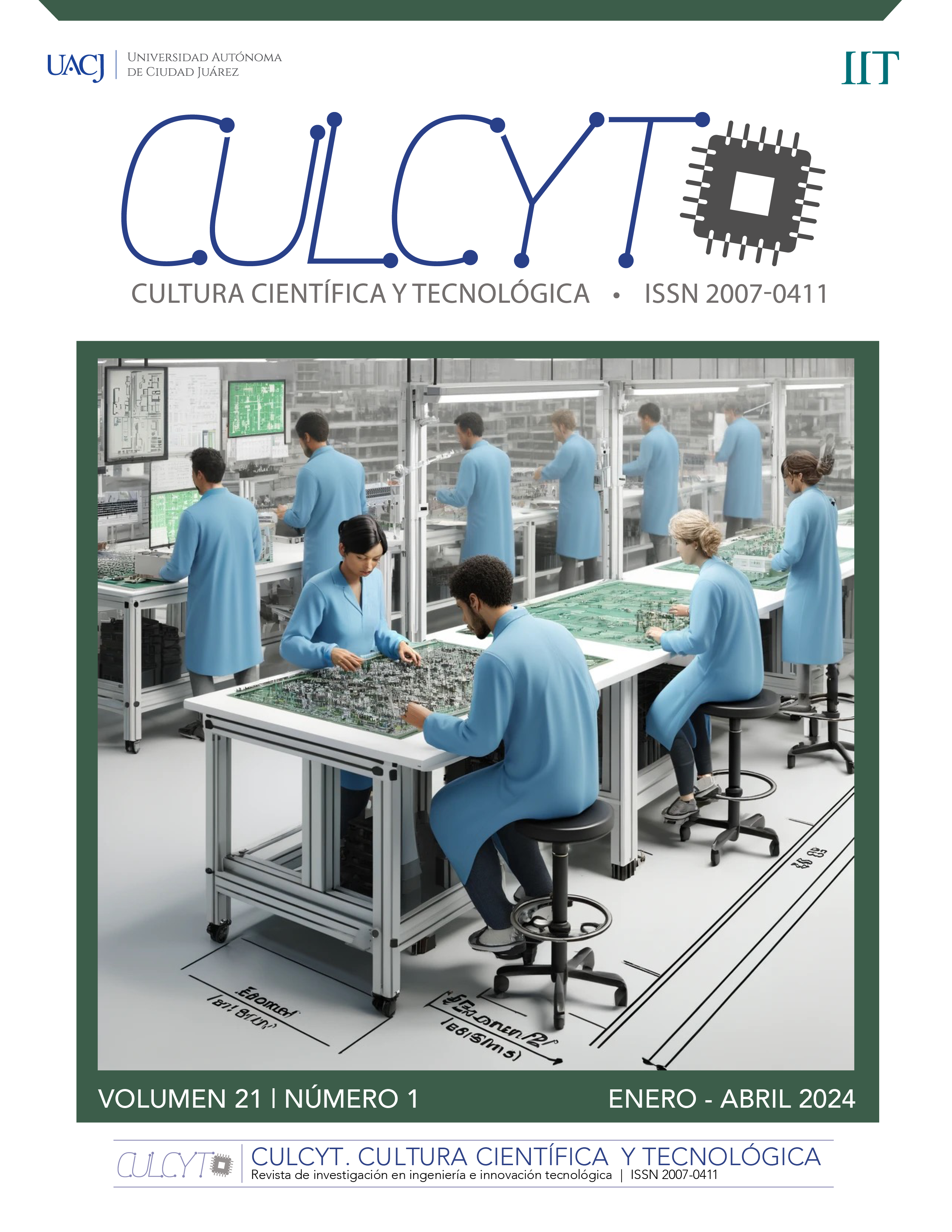Proposal for Ergonomic Improvements for the Audit Workstation: Applying the Nordic Questionnaire and R.O.S.A. Method
DOI:
https://doi.org/10.20983/culcyt.2024.1.2e.6Keywords:
ergonomía, trastornos musculoesqueléticos, Método ROSA, Cuestionario Nórdico, salud ocupacionalAbstract
This research focused on improving the health and welfare conditions of office workers, with the analysis of operations commonly performed in the internal audit area of an agricultural company, as well as the application of ergonomic methods to evaluate and propose improvement strategies that allow a safe working environment reflected in the reduction of MSDs (Musculoskeletal Disorders) seeking to implement methods to develop appropriate strategies and support the management of ergonomic programs that can be implemented as part of daily activities, and in optimal performance in production and quality indexes, obtaining from the exhaustive ergonomic evaluation performed in the workstation several key ergonomic risk factors associated with workstation design, load handling, movement patterns and environmental elements. These factors collectively contributed to the discomfort experienced by the worker, particularly in the back and shoulder areas, due to sustained improper postures and prolonged static positions. The different risk factors were analyzed and improvements from the ergonomic approach were applied, obtaining more favorable results in the second ergonomic evaluation.
Downloads
References
J. M. Y. Chim, “The FITS model office ergonomics program: a model for best practice”, Work, vol. 48, n.° 4, pp. 495-501 2014, doi: 10.3233/WOR-131806.
L. Bernfort, J. Persson, C. Linderothy K. Ekberg, “Supervisor ratings of productivity loss associated with presenteeism and sick leave due to musculoskeletal disorders and common mental disorders in Sweden”, Work, vol. 68, n.° 4, pp. 1091-1100, 2021, doi: 10.3233/WOR-213439.
A. A. Shikdar y M. A. Al-Kindi, “Office Ergonomics: Deficiencies in Computer Workstation Design”, Int. J. Occupational Saf. Ergonom., vol. 13, n.º 2, pp. 215-223, 2007, doi: 10.1080/10803548.2007.11076722.
H. O. Kalte et al., “Use of the Finnish method to quantify the ergonomic properties in an office environment among the workplaces in an Electricity Distribution Company in West Tehran Province”, Electron. Physician, vol. 6, n.° 1, pp. 779-785, 2014, doi: 10.14661/2014.779-785.
C. T. J. Hulshof et al., “The effect of occupational exposure to ergonomic risk factors on osteoarthritis of hip or knee and selected other musculoskeletal diseases: A systematic review and meta-analysis from the WHO/ILO Joint Estimates of the Work-related Burden of Disease and Injury”, Environ. Int., vol. 150, p. 106349, 2021, doi: 10.1016/j.envint.2020.106349.
S. Carter et al., “Using an e-Health Intervention to Reduce Prolonged Sitting in UK Office Workers: A Randomised Acceptability and Feasibility Study”, Int. J. Environ. Res. Public Health, vol. 17, n.º 23, 2020 doi: 10.3390/ijerph17238942.
C. Jensen, C. U. Ryholt, H. Burr, E. Villadsen y H. Christensen. “Work-related psychosocial, physical and individual factors associated with musculoskeletal symptoms in computer users”, Work & Stress, vol. 16, n.º 2, pp. 107-120, 2002, doi: 10.1080/02678370210140658.
P. Akhil, “Ergonomic Assessment in the Workplace." Journal of ergonomics”, J Ergonomics, vol. 11, n.º S2, 2021.
P. R. Mondelo, E. Gregori, Ó. P. González y M. Á. Gómez, El trabajo en oficinas, Ergonomía 4, 2.ª ed. Barcelona: Universitat Politècnica de Catalunya / Mutua Universal, 2013. [En línea]. Disponible en: https://upcommons.upc.edu/bitstream/handle/2099.3/36777/9788476539828.pdf
A. Chairani, “Validity and reliability test of the Nordic musculoskeletal questionnaire with formal and informal sector workers”, en The 7th International Conference on Public Health, Solo, Indonesia, nov. 18-19, 2020, doi: 10.26911/the7thicph-FP.05.06.
A. S. Sahlabadi, A. Karim, A. Khatabakhsh y H. Soori, “Ergonomic Evaluation of Office Staff by Rapid Office Strain Assessment Method and Its Relationship with the Prevalence of Musculoskeletal Disorders”, Journal of Health, vol. 11, n.° 2, pp. 223-234, 2020, doi: 10.29252/j.health.11.2.223.
O. Adiyanto, E. Mohamad, R. Jaafar, F. Ma'ruf, M. Faishal y A. Anggraeni. “Application of Nordic Body Map and Rapid Upper Limb Assessment for Assessing Work-related Musculoskeletal Disorders: A case study in Small and Medium Enterprises”, Int. J. Integr. Eng., vol. 14, n.° 4, 2022, doi: 10.30880/ijie.2022.14.04.002.
Downloads
Published
How to Cite
Issue
Section
License
Copyright (c) 2024 Christian Cisneros-Cervantes, Dr. Ismael Mendoza-Muñoz, Mildrend Montoya-Reyes, Gabriela Jacobo-Galicia, Olivia Yessenia Vargas-Bernal

This work is licensed under a Creative Commons Attribution-NonCommercial 4.0 International License.
Todos los contenidos de CULCYT se distribuyen bajo una licencia de uso y distribución “Creative Commons Reconocimiento-No Comercial 4.0 Internacional” (CC-BY-NC). Puede consultar desde aquí la versión informativa de la licencia.
Los autores/as que soliciten publicar en esta revista, aceptan los términos siguientes: a) los/las autores/as conservarán sus derechos de autor y garantizarán a la revista el derecho de primera publicación de su obra; y b) se permite y recomienda a los/las autores/as agregar enlaces de sus artículos en CULCYT en la página web de su institución o en la personal, debido a que ello puede generar intercambios interesantes y aumentar las citas de su obra publicada.



